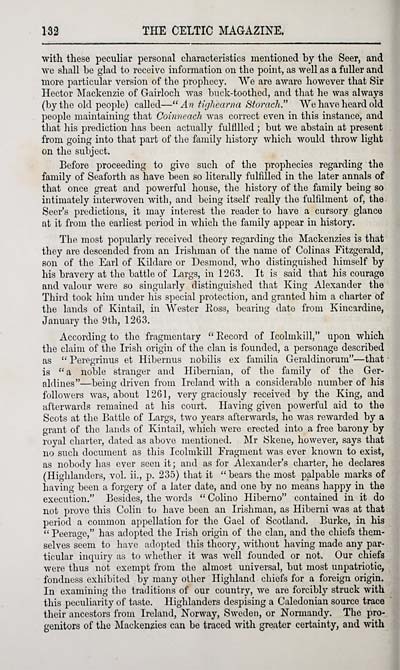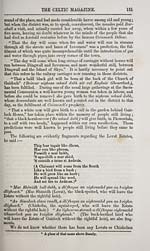Blair Collection > Celtic magazine > Volume 2
(142)
Download files
Complete book:
Individual page:
Thumbnail gallery: Grid view | List view

132 THE CELTIC MAGAZINE.
with these peculiar personal characteristics mentioned by the Seer, and
we shall be glad to receive information on the point, as well as a fuller and
more particular version of the prophecy. We are aware however that Sir
Hector ]\Iackenzie of Gairloch was buck-toothed, and that he was always
(by the old people) called — " A7i tiglieama Storach." We have heard old
people maintaining that Coinneach was correct eveir in this instance, and
that liis prediction has been actually fulfilled ; but we abstain at present
from going into that part of the family history which would throw light
on tlie subject.
Before proceeding to give such of the prophecies regarding the
family of Seaforth as have been so literally fulfilled in the later annals of
that once great and powerful house, the history of the family being so
intimately interwoven with, and being itself really the fulfilment of, the
Seer's predictions, it may interest the reader to have a cursory glance
at it from the earliest period in Avhicli the family appear in history.
The most popularly received theory regarding the Mackenzies is that
they are descended from an Irishman of the name of Colinas Fitzgerald,
son of the Earl of Kildare or Desmond, Avho distinguished himself by
his bravery at the battle of Largs, in 1263. It is said that his courage
and valour were so singularly distinguished that King Alexander the
Third took him under his special protection, and granted him a charter of
the lands of Kintail, in Wester Eoss, bearing date from Kincardine,
January the 9th, 12C3.
According to the fragmentary " Eecord of Icolmkill," upon which
the claim of the Irish origin of the clan is founded, a personage described
as " Peregrinus et Hibernus nobilis ex familia Geraldinorum" — that ■
is "a noble stranger and Hibernian, of the family of the Ger-
aldines" — being driven from Ireland with a considerable number of his
followers was, about 1261, very graciously received by the King, and
afterwards remained at his court. Having given powerful aid to the
Scots at the Battle of Largs, two years afterwards, he was rewarded by a
grant of the lands of Kintail, which were erected into a free barony by
royal charter, dated as above mentioned. Mr Skene, however, says that
no such document as this Icolmkill Fragment was ever known to exist,
as nobody has ever seen it; and as for Alexander's charter, he declares
(Highlanders, vol. ii., p. 235) that it "bears the most palpable marks of
having been a forgery of a later date, and one by no means happy in the
execution." Besides, the words " Colino Hiberno" contained in it do
not prove this Colin to have been an Irishman, as Hiberni was at that
period a common appellation for the Gael of Scotland. Burke, in his
" Peerage," has adopted the Irish origin of the clan, and the chiefs them-
selves seem to have adopted this theory^ without having made any par-
ticular inquiry as to whether it was well founded or not. Our chiefs
were thus not exempt from the almost universal, but most unpatriotic,
fondness exhibited by many other Highland chiefs for a foreign origin.
In examining the traditions of our country, we are forcibly struck with
this peculiarity of taste. Highlanders despising a Caledonian source trace
their ancestors froui Ireland, Norway, Sweden, or Normandy. The pro-
genitors of the Mackenzies can be traced with greater certainty, and with
with these peculiar personal characteristics mentioned by the Seer, and
we shall be glad to receive information on the point, as well as a fuller and
more particular version of the prophecy. We are aware however that Sir
Hector ]\Iackenzie of Gairloch was buck-toothed, and that he was always
(by the old people) called — " A7i tiglieama Storach." We have heard old
people maintaining that Coinneach was correct eveir in this instance, and
that liis prediction has been actually fulfilled ; but we abstain at present
from going into that part of the family history which would throw light
on tlie subject.
Before proceeding to give such of the prophecies regarding the
family of Seaforth as have been so literally fulfilled in the later annals of
that once great and powerful house, the history of the family being so
intimately interwoven with, and being itself really the fulfilment of, the
Seer's predictions, it may interest the reader to have a cursory glance
at it from the earliest period in Avhicli the family appear in history.
The most popularly received theory regarding the Mackenzies is that
they are descended from an Irishman of the name of Colinas Fitzgerald,
son of the Earl of Kildare or Desmond, Avho distinguished himself by
his bravery at the battle of Largs, in 1263. It is said that his courage
and valour were so singularly distinguished that King Alexander the
Third took him under his special protection, and granted him a charter of
the lands of Kintail, in Wester Eoss, bearing date from Kincardine,
January the 9th, 12C3.
According to the fragmentary " Eecord of Icolmkill," upon which
the claim of the Irish origin of the clan is founded, a personage described
as " Peregrinus et Hibernus nobilis ex familia Geraldinorum" — that ■
is "a noble stranger and Hibernian, of the family of the Ger-
aldines" — being driven from Ireland with a considerable number of his
followers was, about 1261, very graciously received by the King, and
afterwards remained at his court. Having given powerful aid to the
Scots at the Battle of Largs, two years afterwards, he was rewarded by a
grant of the lands of Kintail, which were erected into a free barony by
royal charter, dated as above mentioned. Mr Skene, however, says that
no such document as this Icolmkill Fragment was ever known to exist,
as nobody has ever seen it; and as for Alexander's charter, he declares
(Highlanders, vol. ii., p. 235) that it "bears the most palpable marks of
having been a forgery of a later date, and one by no means happy in the
execution." Besides, the words " Colino Hiberno" contained in it do
not prove this Colin to have been an Irishman, as Hiberni was at that
period a common appellation for the Gael of Scotland. Burke, in his
" Peerage," has adopted the Irish origin of the clan, and the chiefs them-
selves seem to have adopted this theory^ without having made any par-
ticular inquiry as to whether it was well founded or not. Our chiefs
were thus not exempt from the almost universal, but most unpatriotic,
fondness exhibited by many other Highland chiefs for a foreign origin.
In examining the traditions of our country, we are forcibly struck with
this peculiarity of taste. Highlanders despising a Caledonian source trace
their ancestors froui Ireland, Norway, Sweden, or Normandy. The pro-
genitors of the Mackenzies can be traced with greater certainty, and with
Set display mode to: Large image | Transcription
Images and transcriptions on this page, including medium image downloads, may be used under the Creative Commons Attribution 4.0 International Licence unless otherwise stated. ![]()
| Early Gaelic Book Collections > Blair Collection > Celtic magazine > Volume 2 > (142) |
|---|
| Permanent URL | https://digital.nls.uk/78481858 |
|---|
| Description | Volume II, 1877. |
|---|---|
| Shelfmark | Blair.3 |
| Attribution and copyright: |
|
| Description | A selection of books from a collection of more than 500 titles, mostly on religious and literary topics. Also includes some material dealing with other Celtic languages and societies. Collection created towards the end of the 19th century by Lady Evelyn Stewart Murray. |
|---|
| Description | Selected items from five 'Special and Named Printed Collections'. Includes books in Gaelic and other Celtic languages, works about the Gaels, their languages, literature, culture and history. |
|---|

